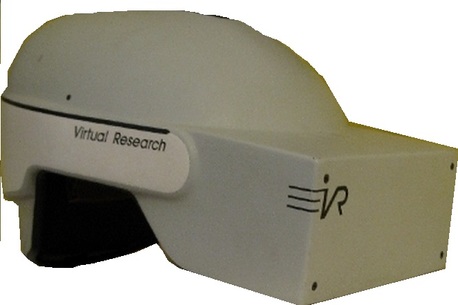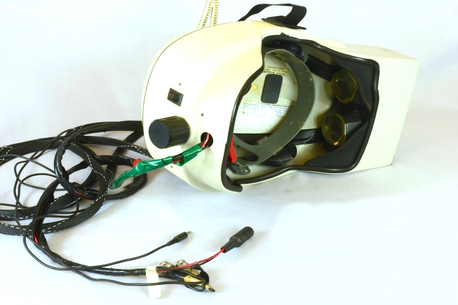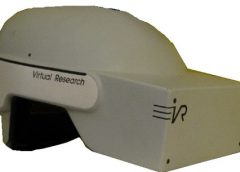
About: The Flight Helmet is your window to the virtual world. A position sensor mounted on the helmet tells the computer the direction you’re looking. The computer generates stereo images that you view on colour LCD displays through wide-angle optics. As you turn your head, the view changes. The result: You are surrounded by a computer-generated world. The Flight Helmet brings a new level of comfort and convenience to virtual reality. The helmet is lightweight (under 4 lbs) and carefully balanced. Because the headband adjusts with a single knob, the Flight Helmet is exceptionally easy to put on. When the headband is opened, the earphones move outward and the helmet slips onto your head. With a quick twist of the knob. the headband and earphones snug up. Flip the power switch and you’re ready to fly. The Flight Helmet is designed with the flexibility to suit your needs. You specify the position sensor you want, and we’ll build it in. If you want to display monoscopic images, we can supply removable lenses that allow your eyes to converge the images. Video signals are NTSC composite, so you can input from a variety of common sources.
Flight Helmet Specs and Info…
Device: Flight Helmet
Manufacturer: Virtual Research
Announced Date: Unknown
Release Date: April 1991
Launch Price: $6,000 (£4,420)
Device Type: VR Headset (PC Powered)
Display: 6.9 cm LCD screens with LEEP Systems 360 X 240 (Per Eye)
Diagonal Field of View(FOV): 100°
Refresh Rate: 30 Hz
Weight: 1670 g (3.68 lb)
CPU: N/A
GPU: N/A
Battery: N/A
Tracking: 3 DoF Non-positional (Gyroscope Based)
Controllers: N/A

Our Thoughts: The Flight Helmet from Virtual Research comes in a few models. The Eyegen3 and the VR4 are both part of this original product. As with all Virtual Research headsets, these are not for public use. It goes without saying that the Flight Helmet is mostly used within the avionics industry. Released in August of 1991 it was designed around a 2.7” LCD displays and LEEP optics making it an impressive headset even in today terms.
Later models like the VR4 features bigger and wide FOV’s and even more power. While not much good to home use, this is one of those VR headsets that will become a historical collectors item in the very near future. Some people think the past releases of virtual reality was a failure, but you only need to see the road that Virtual Research has gone down to see that in reality it was a success.
Sources used…
- https://vrtifacts.com/flight-helmet-redux/
